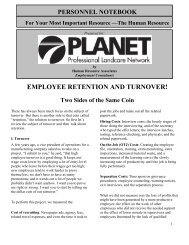Economic Impacts of the Green Industry in the - Urban Forest ...
Economic Impacts of the Green Industry in the - Urban Forest ...
Economic Impacts of the Green Industry in the - Urban Forest ...
You also want an ePaper? Increase the reach of your titles
YUMPU automatically turns print PDFs into web optimized ePapers that Google loves.
The o<strong>the</strong>r dom<strong>in</strong>ant mass marketer type is <strong>the</strong> home improvement/hardware/home center, dom<strong>in</strong>ated by Home<br />
Depot and Lowe’s. These retailers focus on bedd<strong>in</strong>g and garden plants to accompany <strong>the</strong>ir l<strong>in</strong>es <strong>of</strong> trees and<br />
shrubs and lawn and garden hard goods (garden tools, fertilizers and chemicals, lawn mowers, hoses, and<br />
spr<strong>in</strong>klers, etc.), but <strong>the</strong>y also carry both potted flower<strong>in</strong>g and foliage plants on a weekly basis <strong>in</strong> established<br />
garden departments. At Easter and Christmas, <strong>the</strong>se retailers also display racks <strong>of</strong> lilies and po<strong>in</strong>settias throughout<br />
<strong>the</strong>ir stores.<br />
CONSUMER TRENDS<br />
Consumers are very divided by <strong>the</strong> various retail opportunities for nursery and floricultural products. First, it must<br />
be noted that <strong>the</strong>re are very few retailers that can carry a mix that is representative <strong>of</strong> all <strong>of</strong> <strong>the</strong> major <strong>in</strong>dustry<br />
segments (nursery crops, cut flowers, potted flower<strong>in</strong>g plants, foliage plants, and bedd<strong>in</strong>g/garden plants). Hence,<br />
many consumers are forced to shop among several retailer types to see <strong>the</strong> full array <strong>of</strong> product opportunities.<br />
Second, retailers vary dramatically <strong>in</strong> <strong>the</strong> selection <strong>of</strong>fered, as well as <strong>the</strong> qualities, quantities, and sizes <strong>in</strong> <strong>the</strong><br />
products and services <strong>the</strong>y provide. Hence, if consumers have particular needs <strong>in</strong> m<strong>in</strong>d, <strong>the</strong>y may be forced to<br />
shop around to f<strong>in</strong>d <strong>the</strong>ir ideal retail <strong>of</strong>fer<strong>in</strong>g. Of course, pric<strong>in</strong>g varies among <strong>the</strong> retailers, as well.<br />
Work<strong>in</strong>g on <strong>the</strong> side <strong>of</strong> many retailers is <strong>the</strong> overall lack <strong>of</strong> knowledge by <strong>the</strong> majority <strong>of</strong> consumers about <strong>the</strong><br />
<strong>in</strong>dustry’s products. For mass marketers, <strong>the</strong> lack <strong>of</strong> knowledge by <strong>the</strong> average lawn and garden consumer makes<br />
retail<strong>in</strong>g a generic selection <strong>of</strong> dom<strong>in</strong>ant varieties and colors quite acceptable, especially if <strong>the</strong> retailer is able to<br />
attract consumers through <strong>the</strong> lowest price. For <strong>the</strong> traditional retailer able to attract <strong>the</strong> flower or plant aficionado<br />
through better quality, wider selection, or better service, <strong>the</strong> niche opportunities provide <strong>the</strong>ir raison d’être. Yet,<br />
consumers <strong>in</strong>creas<strong>in</strong>gly report that if <strong>the</strong>y know what <strong>the</strong>y want and <strong>the</strong>y are look<strong>in</strong>g for <strong>the</strong> bread-and-butter<br />
staples, <strong>the</strong>y can get a great deal by buy<strong>in</strong>g at mass marketers.<br />
PRODUCER CHALLENGES<br />
The evolv<strong>in</strong>g marketplace has certa<strong>in</strong> challenges for <strong>the</strong> grower. In many <strong>in</strong>stances, buyers for mass marketers<br />
have added what must be considered artificial conditions to <strong>the</strong> buy<strong>in</strong>g arrangements. Some buyers have added<br />
“pseudo grades and standards” to plants based on shelv<strong>in</strong>g heights or personal preferences, ra<strong>the</strong>r than based on<br />
generally accepted plant-to-pot ratios; sometimes <strong>the</strong>se conditions are set only to allow <strong>the</strong> retailer to better<br />
exhibit various differences among groups <strong>of</strong> plants be<strong>in</strong>g sold at different price po<strong>in</strong>ts. Premium versus<br />
promotional plants be<strong>in</strong>g sold side-by-side provides an example. Ironically, such conditions sometimes make it<br />
easier for <strong>the</strong> un<strong>in</strong>formed consumers to recognize differences for <strong>the</strong>ir dollars. However, growers are sometimes<br />
forced ei<strong>the</strong>r to sell perfectly acceptable plants at discounts because <strong>the</strong>ir dimensions fail to measure up to a<br />
particular buyer’s prerequisites or to culturally curtail plant growth to keep plants with<strong>in</strong> <strong>the</strong> standards. Growers<br />
also are forced to choose among production strategies depend<strong>in</strong>g on <strong>the</strong> desired market outlet. On <strong>the</strong> one hand,<br />
growers produc<strong>in</strong>g for mass marketers typically will grow large quantities <strong>of</strong> a limited number <strong>of</strong> products <strong>in</strong><br />
highly automated operations. On <strong>the</strong> o<strong>the</strong>r hand, growers produc<strong>in</strong>g for <strong>in</strong>dependents typically will grow fewer<br />
numbers <strong>of</strong> a wider selection <strong>of</strong> products <strong>in</strong> much less-automated surround<strong>in</strong>gs.<br />
Consolidation <strong>of</strong> retailers has also presented some not-so-obvious market<strong>in</strong>g challenges for growers. There are<br />
<strong>in</strong>stances <strong>in</strong> <strong>the</strong> marketplace where buyers are plac<strong>in</strong>g real or suggested limits on producers about which<br />
competitors <strong>the</strong>y can sell to or on how much <strong>of</strong> a producer’s output <strong>the</strong>y are will<strong>in</strong>g to buy. The restra<strong>in</strong>t <strong>of</strong> trade<br />
issues notwithstand<strong>in</strong>g, such actions limit producer options. Growers rightfully want to spread <strong>the</strong>ir eggs among<br />
as many baskets as possible, but options are dw<strong>in</strong>dl<strong>in</strong>g as certa<strong>in</strong> cha<strong>in</strong>s cont<strong>in</strong>ue to consolidate and as f<strong>in</strong>ancial<br />
realities force smaller cha<strong>in</strong>s and/or <strong>in</strong>dependents out <strong>of</strong> bus<strong>in</strong>ess.<br />
In many markets, <strong>the</strong> big box cha<strong>in</strong>s <strong>of</strong>ten come onto <strong>the</strong> scene open<strong>in</strong>g huge numbers <strong>of</strong> stores <strong>in</strong> a relatively<br />
short time. While this is <strong>the</strong> nature <strong>of</strong> mass markets, <strong>the</strong>se actions, which have forced smaller retailers from <strong>the</strong><br />
scene, have also had <strong>the</strong> effect <strong>of</strong> forc<strong>in</strong>g producers to scramble to ma<strong>in</strong>ta<strong>in</strong> any market opportunities to which<br />
<strong>the</strong>y can sell. Sometimes <strong>the</strong> cha<strong>in</strong>s enter a new market and br<strong>in</strong>g established supply relationships with <strong>the</strong>m from<br />
distant locations, ra<strong>the</strong>r than develop<strong>in</strong>g new relationships with local producers. With alternative local retailers<br />
pressured, local growers <strong>of</strong>ten f<strong>in</strong>d <strong>the</strong>mselves challenged to f<strong>in</strong>d an <strong>in</strong>vit<strong>in</strong>g market channel.<br />
Conversely, as cha<strong>in</strong>s move from market to market, a number <strong>of</strong> buyers have asked growers to supply not only<br />
those stores that have been supplied <strong>in</strong> <strong>the</strong> past, but also additional stores be<strong>in</strong>g built or acquired. Due to<br />
15
















